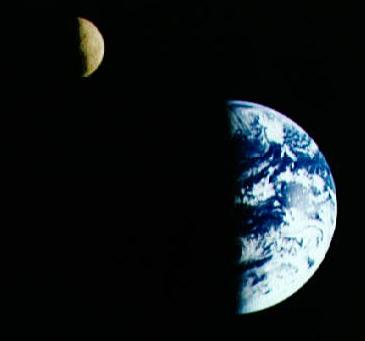Origin of the Moon still remains a puzzle for scientists
Planet Earth has the largest moon in the solar system in respect of the planet's own size
President George Bush's announcement of USA's plans to land on the Moon with a view to colonize the Earth's natural satellite, spurred more discussion about the origin of the Moon. The most common version says that the Moon appeared when a Mars-sized celestial body collided with young Earth. Scientists still do not know the answer to the mysterious question, though. 
Six Apollo crews landed on the Moon from 1969 to 1972. They delivered 380 kilos of the moon's soil to Earth. Soviet space probes worked on the moon on three occasions in 1969-1976 and gave scientists an opportunity to examine 330 grams of regolith. Regolith was delivered to planet Earth from nine areas of the Moon. It is an absolutely safe substance of gray color, which represents dust and small particles. It was proved as a result of a lab research that the chemical structure of the Moon and Earth had a striking difference. Therefore, the version of a direct connection between the Moon and Earth does not seem to be possible.
There are three key versions about the origin of the Moon. The first one of them says that Earth was revolving too fast, which eventually made the planet get rid of a certain part of its matter, which subsequently formed the Moon. The second one says that the moon came from deep black space and was seized with the power of the Earth's gravity. According to the third version, the Earth and the Moon were formed independently, almost simultaneously and at about one and the same distance from the Sun.
One of the latest scientific researches resulted in the fourth theory of the “grand stroke,” which is considered to be the most trustworthy version in the scientific world. A large celestial body, the size of which could be compared to the size of planet Mars, slammed into Proto-Earth (very young Earth) 4.5 billion years ago. Numerous fragments of the planet formed a circle of pieces around the planet: the fragments stuck together around the largest one of them and formed the moon.
The theory was announced for the first time in 1975 in the USA, when American scientists completed the first analysis of the moon's soil. It was particularly discovered that the content of iron on Earth was very high as opposed to its meager amount on the Moon. In addition, the collision resulted in a massive emission of gas, particularly oxygen. The moon was originally 20 times closer to Earth than it is now – it was gradually moving aside from the planet to the orbit, where it is currently staying.
Princeton University professors Richard Gott and Edward Belbruno set forth a theory, which could brush aside the scientific mystery of the moon's formation and add a curious detail to the issue of the quest for extraterrestrial civilizations.
The comparison of oxygen isotopes on the Moon and Earth shows that they both are of one and the same age. A giant impactor must have appeared nearby in an orbit similar to that of Earth. Outstanding French mathematician Lagrange discovered two places like this in the solar system, situated on Earth's orbit, 60 degrees in front of and behind our planet as it circles the Sun. The formation of a Mars-sized planet was quite possible in one of such spots; the planet could orbit the Sun on the Earth's circular path too. When the new planet reached a larger mass, the gravitational influence of other planets (especially the one of Jupiter) pushed the planet out of the Lagrangian point. The killer planet continued its last flight towards planet Earth, in which it eventually slammed. A computer analysis of the described process shows that the collision was inevitable.
Planet Earth has the largest moon in the solar system in respect of the planet's own size (except for Pluto – some scientists do not even ascribe this planet to the solar system). A large moon plays a very important role in the natural world. If Earth had no Moon, the Earth's axe would be constantly changing, inciting drastic climate changes that would lead to lamentable consequences for all living beings. The moon's gravity smoothes out such oscillations and stabilizes the climate. Lunar tides, which are three times longer than their solar analogues, played the key role in the origin of life on the planet. It brings up the idea that extraterrestrial forms of life could be possible in planetary systems, similar to the couple of the Moon and Earth.
Are there any other celestial bodies in the solar systems, which could possess such monstrous destructive capacity as the above-mentioned impactor? Asteroid 2002 AA29, the size of a boulder, could play such a role, some scientists believe. The asteroid's orbit periodically takes its to the distance of 5.8 million kilometers from Earth. This specific orbit is similar to the one of the impactor's, on which it was probably moving 4.5 billion years ago. It is not ruled out that the 2002 AA29 asteroid carries the material, of which the impactor, the moon and Earth were once created.
It is worth mentioning that scientists could organize a space mission to the above-mentioned asteroid and obtain its soil samples with the help of a space probe. Such a mission is not being planned yet, although the asteroid could be probably considered one of the most valuable rocks in the solar system.
Russian academician Oleg Bogatikov has recently conducted a special research with the use of scanning X-ray microscopes. The scientist came to conclusion that the Moon and Earth had different scenarios of their development. The Moon's oldest rock is more than four billion years old. The age of the Earth's oldest rock reaches 1.2-2.6 billion years. Therefore, Bogatikov believes, early stages of development of planet Earth and its natural satellite did not coincide with each other. Most likely, the planet and its satellite originated from different proto-planetary matter.
Subscribe to Pravda.Ru Telegram channel, Facebook, RSS!





